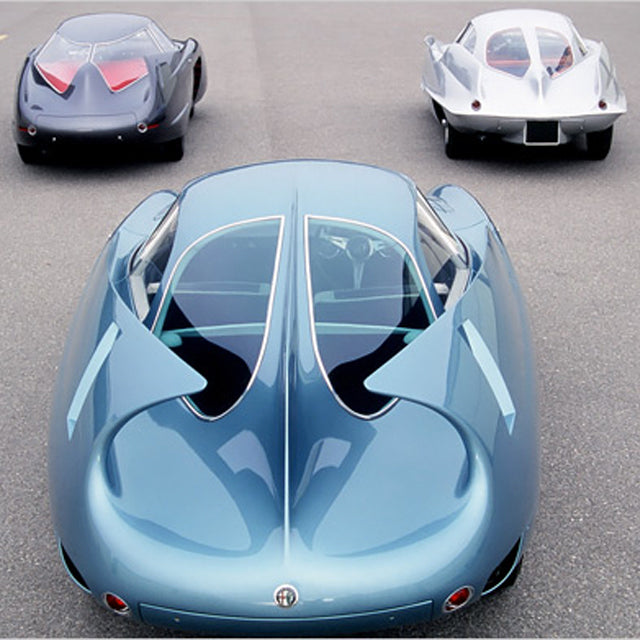Franco was born on September 26, 1916 in Florence, Italy to Mr. Vittorio Scaglione, a chief army doctor and Ms. Giovanna Fabbri, captain of the Italian Red Cross service.
Franco joined the military at the outbreak of World War II when his aero engineering studies were interrupted and was eventually deployed to Libya. On Christmas Eve 1941, he was taken prisoner by the British at El Duda, a village to the south of Tobruk and was sent to Yol Detention Camp in India, where he remained until the end of 1946. When he was released, he rejoined his mother in Carolei, near Cosenza, and stayed with her for almost a year.
In early 1948, Franco travelled to Bologna in search of a job, with his mind set on becoming a stylist in the auto industry. Initially, he devoted his time to sketching clothing for various fashion houses, which turned out to be lucrative, but didn’t let it get in way of his passion for auto coachwork design. Later that year, he married Maria Luisa Benvenuti and two years later, his daughter Giovanna was born.
Wanting to be near the major coachbuilding firms, he relocated to Torino in 1951 and contactedMr. Battista (Pinin) Farina who liked his work; however, a collaboration ultimately never materialized. Shortly afterwards, Franco met Mr. Nuccio Bertone and finally a partnership was born, which lead to the creation of the Alfa Romeo B.A.T.s, the Giulietta Sprint and Sprint Speciale, along with others.
The BAT concept car project originated as a joint collaboration between Alfa Romeo and Bertone that began in 1953, culminating in three cars. Alfa Romeo initially contacted Bertone, commissioning three concept vehicles with extensive research on the effects of drag on a vehicle. The idea was to create vehicles with the lowest possible drag coefficient, named BAT for ‘Berlinetta Aerodinamica Tecnica’. All the cars are unique in their appearance, but share similar curved fins, and are based upon an Alfa Romeo 1900 chassis. Each year between 1953 and 1955 at the Turin Auto show, Bertone and Alfa Romeo presented a BAT concept, the BAT 5, 7 and 9. The cars were successful in their goal, the best achieving a drag coefficient of 0.19, which is quite an achievement even by modern standards. For each of the cars, Alfa provided a five-speed gearbox and a four-cylinder engine that produced around 90 horsepower (67 kW), good enough to propel the car to a top speed of 125 mph (201 km/h).
In 1959 Scaglione broke off the relationship with Bertone coachworks and decided to venture out on his own. His first collaboration was with Mr. Carlo Abarth and Porsche, which resulted in the Porsche 356 B Abarth Carrera GTL, the highly-acclaimed design forerunner of the 911.
Franco then penned the Lamborghini 350 GTV as a concept car. During assembly, the workforce discovered that the body panels would not fit around the engine, but since Lamborghini had no further plans for the 350 GTV beyond being a show car, the engine bay was ballasted with bricks and the hood was kept shut throughout the ’63 Torino Auto Show. The incomplete show car also lacked brake calipers, pedals, and windshield wipers. Despite being a non-runner it became the DNA for what would become the first ever Lamborghini road car, the 350 GT, which went on sale the following year.
Scaglione then worked on the mid-engined ATS 2500 GT, the 1900 Skyline Sprint for Prince (Japan), the Titania Veltro GTT, and various models for Intermeccanica such as the Apollo, Torino, Italia GFX, Italia IMX, and the Indra.
But his masterstroke may have come in 1967 when he designed the legendary Alfa Romeo 33 Stradale, a symphony of flowing curvature, which is still today, acknowledged as one of the most beautiful cars ever made; with only eighteen ever built, it’s also one of the most exclusive.
Unfortunately for Franco, Intermeccanica ended up experiencing financial troubles and the entrepreneur owner, Mr. Frank Reisner, moved operations to Canada. With Franco having sunken much of his own savings into the production of the Indra, he became disillusioned with the industry and retired from work. In 1981 he moved to Suvereto, a small village in Tuscany, living a secluded life where his health slowly but steadily declined amid rumors of depression and addiction. In 1991, he was diagnosed with lung cancer, succumbing two years later on 19th of June 1993, aged 76.
Franco Scaglione died in relative obscurity, largely forgotten and under-appreciated for the redirection he gave to auto styling by revitalizing the aerodynamic DNA of many Italian and German brands in the fifties and sixties.
Image Sources:wikipedia.org ,wired.com ,velocissima.com ,carstyling.ru ,mycarquest.com ,conceptcarz.com ,cartype.com ,bozhdynsky.com ,mad4wheels.com ,classiccarcatalogue.com ,ultimostile.com ,velocetoday.com ,alfasport.net




















































